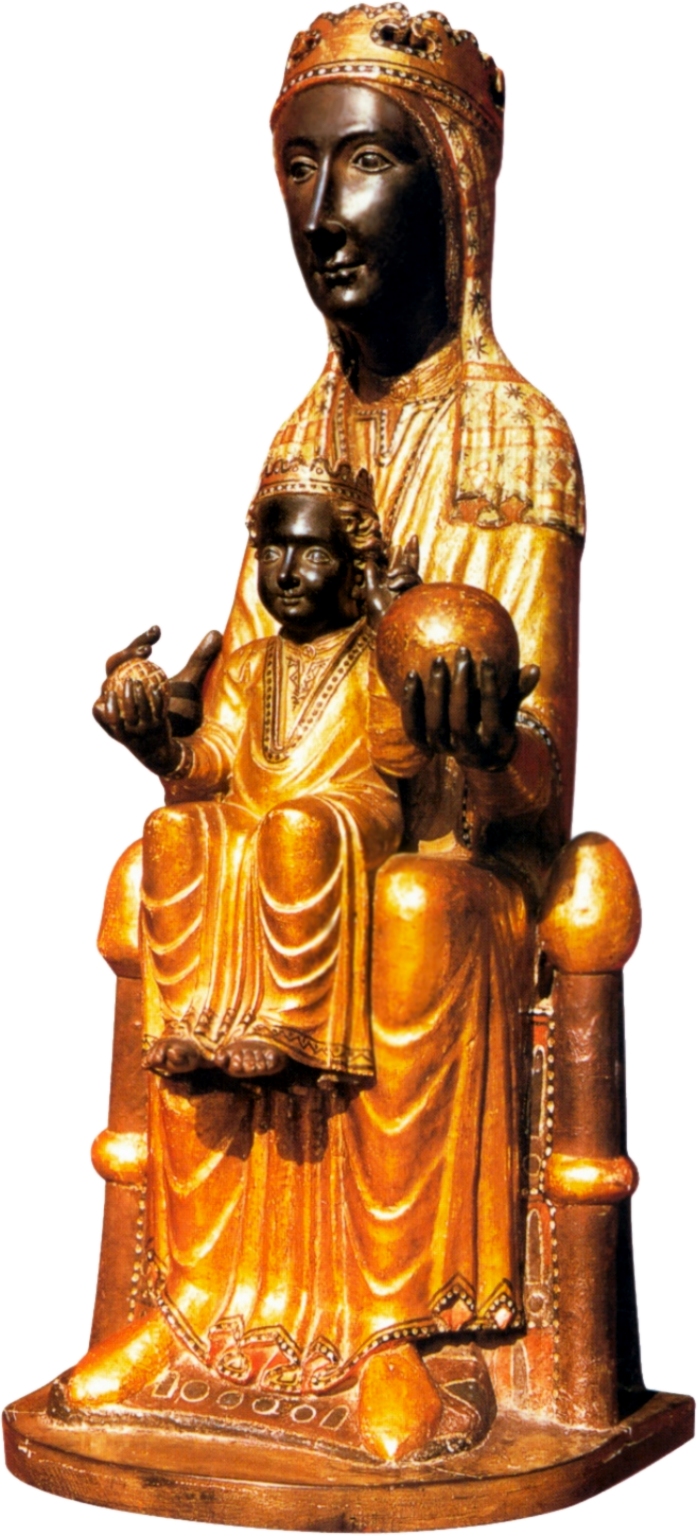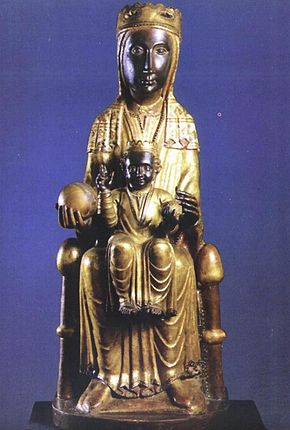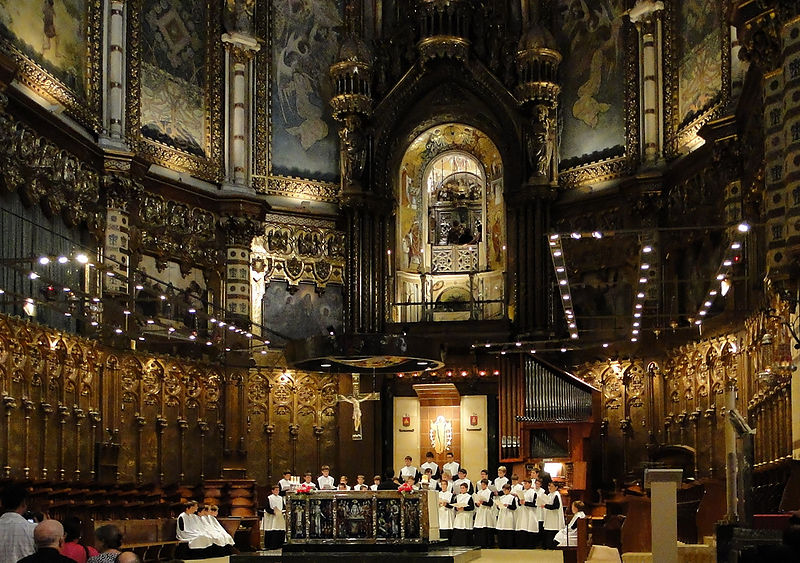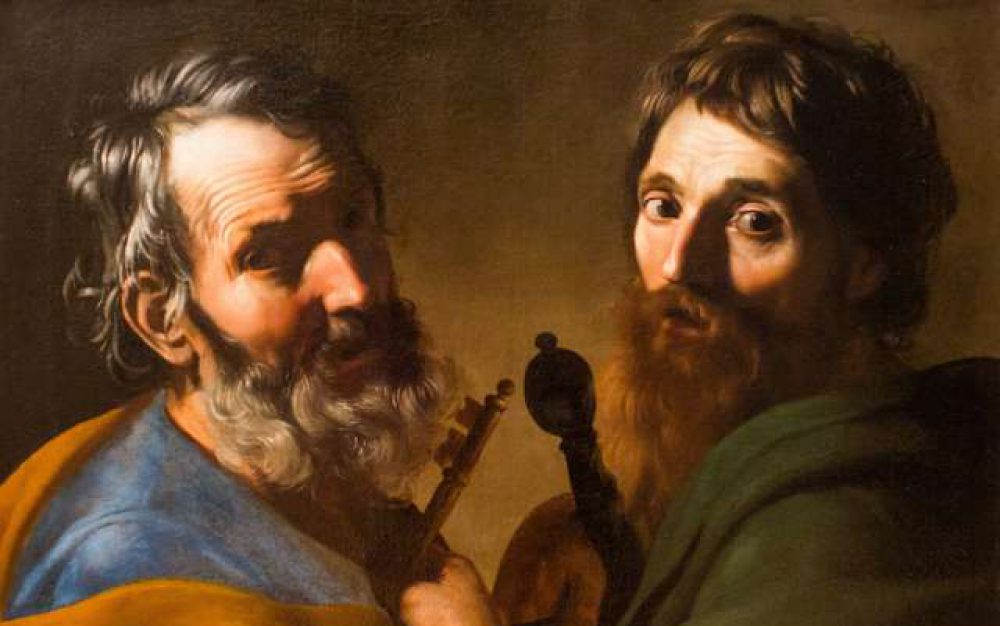Feast of Our Lady of Montserrat (718) – 27 April, is a Marian title associated with a venerated statue of the Madonna and Child venerated at the Santa Maria de Montserrat monastery on the Montserrat Mountain in Catalonia, Spain. She is the Patron Saint of Catalonia, an honour she shares with Saint George (Sant Jordi in Catalan). Pope Leo XIII granted the image a Canonical coronation on 11 September 1881. The image is one of the Black Madonnas of Europe, hence its familiar Catalan name, La Moreneta (“the little dark-skinned one” or “the little dark one”). Believed by some to have been carved in Jerusalem in the early days of the Church, it is more likely a Romanesque sculpture in wood from the late 12th century. An 18th century polychromed statue of the same image is also displayed in Saint Peter’s basilica, previously stored in the Vatican Museums which was gifted by the President of Brazil, Joao Goulart on the Papal election of Pope Paul VI in 1963. The image has been on display for Papal masses since the Pontificate of Pope Benedict XVI.

Blackened by candles that burned before the statue day and night, this particular image dates back to at least the twelfth century. St Ignatius of Loyola made an annual pilgrimage to Montserrat as have a million or more pilgrims every year in modern times.
The mountain named Montserrat rises 20 miles northwest of Barcelona, in the region of Catalonia, which takes it names from the Spanish, Catalan, for “sawn mountain” probably because its rock outgrowths seem to be the teeth of a saw from a distance. These most unusual lofty cone-shaped jags are almost perpendicular. The highest cone rises to a height of nearly 4,000 feet, while the circumference around the entire base of the mountain is measured at about 12 miles. The church which contains the miracle-working statue of the Madonna and Child sits about halfway up the mountain.
According to tradition, the miraculous image was first known as La Jerosolimitana (the native of Jerusalem), since it is thought to have been carved there in the early days of the Church. The statue was eventually given to St Etereo, Bishop of Barcelona, who brought it to Spain.
In the seventh century, when Saracen infidels invaded Spain, the Christians of Barcelona heroically defended it for three years until defeat appeared imminent. Knowing that they could hold out no longer, they decided to take their treasured image of Our Lady to a secret, safe place. Quietly, with the knowledge of the Bishop and the Governor of the city, a group brought the statue to Montserrat, placing it in a small cave, on 22 April 718. A complete account of the origin of the miraculous image, the cause of its removal and the place of its hidden security were recorded and in the archives of Barcelona.
Even though the location of the statue was eventually forgotten, the people of Barcelona never forgot the holy image for almost 200 years. Then, in 890, shepherd boys from Monistrol, a village at the foot of Montserrat, were sent unbeknown to them to be the source of the discovery of the treasure.
While tending their flocks that night the shepherds were surprised by lights and the sound of singing coming from the mountain. When this happened once again, they reported the situation to their priest, who looked into the matter. He, too, heard the singing and saw the mysterious lights, so he reported this to the Bishop, who also witnessed the same occurrences. At last the statue of Our Lady was discovered in the cave and brought out and placed in a small church that was soon built; this little church developed into the present church that was completed in 1592.
In 888 there had already been a chapel dedicated to Our Lady and it was at that spot that the present shrine is located. Eventually a monastery was added, which grew rapidly, because of the miracles wrought there by the Blessed Virgin. According to the caretakers of the shrine, the statue that still presides over the monastery was introduced in the twelfth or thirteenth century. This statue might have replaced an earlier one, which could have been destroyed during one of the many wars.
Carved in wood, the statue is in a sitting position and measures slightly over three feet in height. In Romanesque style, the figure is slender, with an elongated face and a delicate expression. The dress of the Virgin consists of a tunic and cloak both gilded and plain in design which is draped. Beneath the crown is a veil adorned with stars, squares, and stripes in subtle shades of colour. The right hand of the Virgin holds a sphere, while the other is extended in a graceful gesture. The Child Jesus sits on His Mother’s lap and also wears a crown and lovely garments. His right hand is raised in blessing; His left hand holds an object that resembles a large pine cone. A cushion serves as the Madonna’s footrest; she is seated upon a chair that has large legs and whose back is topped by cone-shaped finials. The statue is highly revered not only as a religious treasure but also because of its artistic value. It is almost completely gilded, save the face and hands of both Our Lady and the Child Jesus [and His feet also]. Unlike many old statues which are black because of the kind of wood or the effects of the original paint, the dark colour of Our Lady of Montserrat is attributed to the innumerable candles and lamps used in its veneration. Because of this dark colour it is affectionately called La Moreneta, The Dark Little One. Thus, the Virgin of Montserrat is classified among the Black Madonnas.
The image is in an alcove behind the main altar. It can be reached by climbing decorated stairs to the side of the church. The stairs lead to a large room which is directly behind the alcove where the statue is enthroned. This large room is called the Camarin de La Virgen, the Chamber of the Virgin. A large number of people can fit in the space to pray beside the throne of the Blessed Mother. The pilgrim cannot touch the image, however, since it is protected by a glass.

Although not located on the peak of the mountain as are the sanctuaries of Monte Cassino and Le Puy, the monastery is situated high enough from the surrounding area to make one think it safe from attack. Yet the monastery sustained considerable damage during the Napoleonic invasion. Additional harm was inflicted during civil wars and revolutionary disturbances. The treasured image of the Madonna and Child was hidden during these times but was soon restored to its place of honour when the church and buildings were quickly repaired. These buildings were spared during the Spanish Civil War of 1936-1939 by the Autonomous Government of Catalonia.

Benedictines settled in the monastery hundreds of years ago and still maintain the sanctuary and provide hospitality to the steady stream of pilgrims who go there. The number of historical figures connected to the sanctuary or who have visited it, including one of its hermits, Bernat Boil, who accompanied Christopher Columbus to the New World, thus becoming the first missionary to America. One of Montserrat’s first abbots became Julius II, the Renaissance Pope for whom Michelangelo worked. Emperor Charles V and Philip II of Spain both died with blessed candles from the sanctuary in their hands. King Louis XIV of France had intercessory prayers said at Montserrat for the Queen Mother and Emperor Ferdinand III of Austria made generous financial gifts to the monastery. All the kings of Spain prayed at the shrine, as did Cardinal Roncalli, who later became St Pope John XXIII.


Some of the Saints who visited there were St Peter Nolasco, St Raymond of Penafort, St Vincent Ferrer, St Francis Borgia, St Aloysius Gonzaga, St Joseph Calasanctius, St Anthony Mary Claret and St Ignatius, who as a knight was confessed by one of the monks. After spending a night praying before the image of Our Lady of Montserrat, he began his new life and the founding of Jesuit order. A few miles away is Manresa, a pilgrim shrine of the Society of Jesus. The shrine holds the cave wherein St Ignatius Loyola retired from the world and wrote his Spiritual Exercises.
The Virgin of Montserrat was declared the Patron Saint of the Diocese of Catalonia by Leo XIII. The statue has always been one of the most celebrated images in Spain.
A historian wrote: “In all ages the sinful, the suffering, the sorrowful, have laid their woes at the feet of Our Lady of Montserrat and none have ever gone away unheard or unaided.”


So beautiful! I had the blessing to visit Montserrat a few years ago and prayed to Our Lady of Montserrat! Thank you for sharing 🌹
LikeLike
How wonderful – a blessing indeed My Carmel. Thanks for sharing such joy! Ana
LikeLike
Reblogged this on Die Goldene Landschaft.
LikeLike